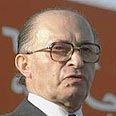
Army was Polish, soldiers were Jews
Exhibition set to open next week salutes anonymous Jewish fighters who fought with Poland’s armies
During their thousand-year sojourn in Poland Jews helped the country flourish, making great contributions in the fields of commerce, industry, crafts, agriculture, and finance, and in the Polish military as well.
Throughout the period in which Jews lived in Poland many Jews served in the Polish army, taking part in the country’s wars and its battles to achieve independence or defend its independence.
Many of the Jewish fighters, some of them senior officers, became legends in the Polish army, such as Lieutenant Colonel Berek Joselewicz, a hero of the Kościuszko uprising in 1794 and the battles against the Russians, Austrians, and Prussians in the years following the uprising.
Joselewicz fell in 1809 in a battle with the Austrians near the city of Kock, becoming a symbol of the joint Polish-Jewish struggle for Polish independence. The Jewish officer was commemorated in history books, stories of heroism studied in military academies, and in a painting by Juliusz Kossak, who showed Joselewicz on horseback with his soldiers.
Fighting against Nazis
Many Jews fought in the war from 1919-1921, when Poland once again was fighting for its independence, this time against the Soviet Union. They excelled in battle and gained their commanders’ esteem for their courage.
During the Nazi occupation from 1939-1945 Jews also did their part as soldiers in the Free Polish Army and as partisans behind enemy lines. It is true that there were partisan units that did not accept Jewish fighters or even harmed them, but this did not prevent Jews from fighting the Germans in all-Jewish units or units with Poles who considered them comrades in arms.
Jews who hid and lived under a Polish identity, and even those who managed to leave the Warsaw Ghetto, which was completely destroyed following the 1943 uprising, took part in the Warsaw uprising led by Bór-Komorowski in the summer of 1944, and many of them were killed.
Exhibition in their memory
The exhibition, set to open next week at the Menachem Begin Heritage Center in Jerusalem, shows the part the Jews played as soldiers and officers in all of Poland’s wars (“Polish Jews—Polish soldiers”). The Israel office of the World Jewish Congress and the Polish Embassy in Israel initiated the exhibition. The guest of honor at the opening ceremony will be Polish President Lech Kaczyński.
The exhibits are from the collection of the Jewish Historical Institute in Warsaw, the central archive of the Polish Army, the Polish National Library, and the Museum of Independence in Warsaw.
According to Polish documents, the percentage of Jews serving in the Polish army in WWII—both when the Germans invaded Poland on September 1, 1939, and in the ranks of the Free Polish Army organized in the Soviet Union and in England—came to 10 percent of the total forces.
In other words, some 100,000 Jewish soldiers and officers fought in the battles following the German invasion, which lasted for 17 days, and nearly 20,000 Jews served in the ranks of the Free Polish Army.
Thousands of Jews fell in the battles, and tens of thousands were taken prisoner together with their Polish comrades. But the Germans did not deal with the approximately 50,000 Jewish POWs according to the Geneva Convention, and most were sent to various concentration camps and from there to extermination in camps in Poland.
Begin was there too
The late Menachem Begin fought in the Second World War as an officer in the ranks of the Free Polish Army under the command of General Wladyslaw Anders. More than 10,000 Jews served in Anders’s Army and fought in the famous battle of Monte Cassino in Italy in 1944. Soldiers from the Jewish Brigade—established a short time earlier as part of the British Army—fought alongside them.
One of the more horrifying events of the Second World War was the Katyn Massacre. In spring 1940, at Stalin’s orders, the Soviets murdered more than 4,000 Polish officers not far from the town of Katyn. The officers were shot in the head and their bodies thrown into a mass grave.
For years the Soviets claimed that the Polish officers had been murdered by the Germans, and in order to back up their claims they buried German clothing, ID cards, and weaponry in the mass grave.
Commissions of inquiry led by experts from all over the world determined that the massacre was perpetrated by the Soviet Union. After the collapse of the Communist regime the Russian authorities admitted that the massacre had been carried out by the previous regime. Those murdered at Katyn included many Jewish officers, among them Major Baruch Steinberg, chief rabbi of the Polish army.
Bobby Brown, Executive Director of the World Jewish Congress in Israel, and one of the initiators of the exhibition, believes that it is not just a fascinating historical document but also part of the struggle for public opinion abroad, including in Poland, with the goal of doing justice to Polish Jewry and Holocaust survivors.










